Google Earth is a great tool and it’s free for everyone to use. No doubt that many of us in the mining industry already use it regularly.
Previously I had written an article about how Google Earth can be used to give your entire engineering team a virtual site visit. It’s cheaper than flying everyone to site. That blog is available at this link “Google Earth – Keep it On Hand”.
What else can Google Earth do for me?
The Investor Relations (IR) department in a mining company can also take advantage of Google Earth’s capabilities. Typically the IR team are responsible for creating a myriad of PowerPoint investor presentations. Their slideshows will include graphics highlighting the project location, showing exploration drilling and planned site facilities for advanced projects. This is where Google Earth can be used to create a more interactive experience for investors.

Google Earth with 3D Buildings
Rather than relying only on PowerPoint, the technical team can create drillhole maps, 3D infrastructure layouts, open pit plans, 3D tailings dams, and import them into Google Earth.
By creating a KMZ file, one can share this information with investors, analysts, and stakeholders. This will provide an interactive opportunity to view the information themselves.
Viewers could fly around the site, zoom in and out as needed, examine things in 3D, and even measure distances. Viewers can even save the project in Google Earth and return back whenever curiosity dictates.
I have been a part of engineering teams where Google Earth has been used to share layout information. However I have not yet seen such information offered as a downloadable KMZ file to external parties. If you know of any companies that are currently doing this, please let me know (kjkltd@rogers.com) and I will share their link here.
There also is VRIFY
VRIFY is a new cloud based platform that provides 3D viewing capability. It provides a map based graphic tool to IR departments for sharing project information. VRIFY can also enhance collaboration among engineering teams by enabling a group to view a virtual project and sketch on the image in real time.

VRIFY desktop screenshot
VRIFY also allows more detailed information to be displayed in the form of hotspots within a project. Click on them to get more information on that topic (see image to the right).
Although I have only been given a demo of VRIFY, it appears to be a nice package that provides more functionality than Google Earth. Unfortunately VRIFY is not free for a company to use. The minimum subscription cost is about $10,000 (plus extras).
In June 2019 VRIFY made a deal with Kirkland Lake Gold whereby interested property vendors can submit their project to Kirkland Lake management for their review.
Here is the link (https://vrify.com/dealroom). In the proposed approach, the project information is submitted using the VRIFY platform. Essentially some of the same information presented in a PowerPoint is now provided in a more interactive fashion. Participating companies must first enter into a client service agreement with VRIFY. We will see how this idea works, since it does add a cost and new complexity for the property vendor.
There is another cloud based service called Reality Check, which offers virtual reality site visits.
Conclusion
The bottom line is that the trend in the mining industry is towards more open data sharing whether you’re connecting with the public or within your own engineering team. New and old cloud based platform tools can be used to do this. It just depends on your budget.
Note: If you would like to get notified when new blogs are posted, then sign up on the KJK mailing list on the website. Otherwise I post notices on LinkedIn, so follow me at: https://www.linkedin.com/in/kenkuchling/.

 In the past there would be binders with detailed calculations and backup for the different parts of the study. Typically there was a binder for the Executive Summary and separate sections (i.e. binders) for Geology, Mining, Processing, Infrastructure, Capital Cost, Operating Cost, Environmental, Project Execution, and Economic Analysis, etc.
In the past there would be binders with detailed calculations and backup for the different parts of the study. Typically there was a binder for the Executive Summary and separate sections (i.e. binders) for Geology, Mining, Processing, Infrastructure, Capital Cost, Operating Cost, Environmental, Project Execution, and Economic Analysis, etc. The original intent of the 43-101 Technical Report was for it to be a summary document, only about 80-150 pages in length. The intent was to simplify all the technical work for the benefit of non-technical investors. Currently I have noticed that in many cases the 43-101 report is now the entire feasibility study document.
The original intent of the 43-101 Technical Report was for it to be a summary document, only about 80-150 pages in length. The intent was to simplify all the technical work for the benefit of non-technical investors. Currently I have noticed that in many cases the 43-101 report is now the entire feasibility study document. My recommendation is that, where budgets permit, mining companies return to the days of preparing the comprehensive feasibility study document. It’s the right thing to do.
My recommendation is that, where budgets permit, mining companies return to the days of preparing the comprehensive feasibility study document. It’s the right thing to do.

 If any mining industry credibility has been lost, re-establishing it should be important. One way to start doing this is to focus on creating the type of reports that best serve the needs of the industry stakeholders.
If any mining industry credibility has been lost, re-establishing it should be important. One way to start doing this is to focus on creating the type of reports that best serve the needs of the industry stakeholders.
 The technology consists of a floating LNG (liquefied natural gas) turbine power plant combined with high capacity seawater desalinization capabilities. MODEC is offering the FSRWP® (Floating Storage Regasification Water-Desalination & Power-Generation) system.
The technology consists of a floating LNG (liquefied natural gas) turbine power plant combined with high capacity seawater desalinization capabilities. MODEC is offering the FSRWP® (Floating Storage Regasification Water-Desalination & Power-Generation) system. From a green mining perspective, the FSRWP produces clean power with the highest thermal efficiency and lowest carbon foot-print.
From a green mining perspective, the FSRWP produces clean power with the highest thermal efficiency and lowest carbon foot-print. Currently there are three mooring options for the floating system that should fit most any tidewater situation.
Currently there are three mooring options for the floating system that should fit most any tidewater situation.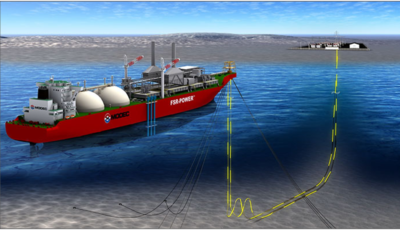 The bottom line is that if your mining project is near shore, and has both water supply and power issues, take a look at the FSRWP technology. One might say it is greener technology by using LNG (rather than coal, heavy fuel oil, or diesel) to generate power. At the same time it avoids competition with locals for access to fresh water.
The bottom line is that if your mining project is near shore, and has both water supply and power issues, take a look at the FSRWP technology. One might say it is greener technology by using LNG (rather than coal, heavy fuel oil, or diesel) to generate power. At the same time it avoids competition with locals for access to fresh water.
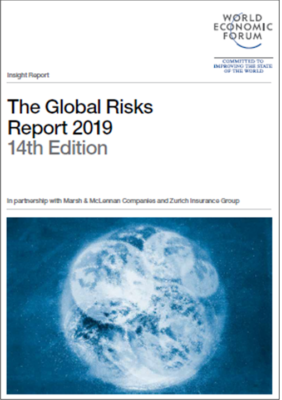 Each year business leaders are queried about what they view as their major risks. The survey results are summarized in the Global Risk Report.
Each year business leaders are queried about what they view as their major risks. The survey results are summarized in the Global Risk Report.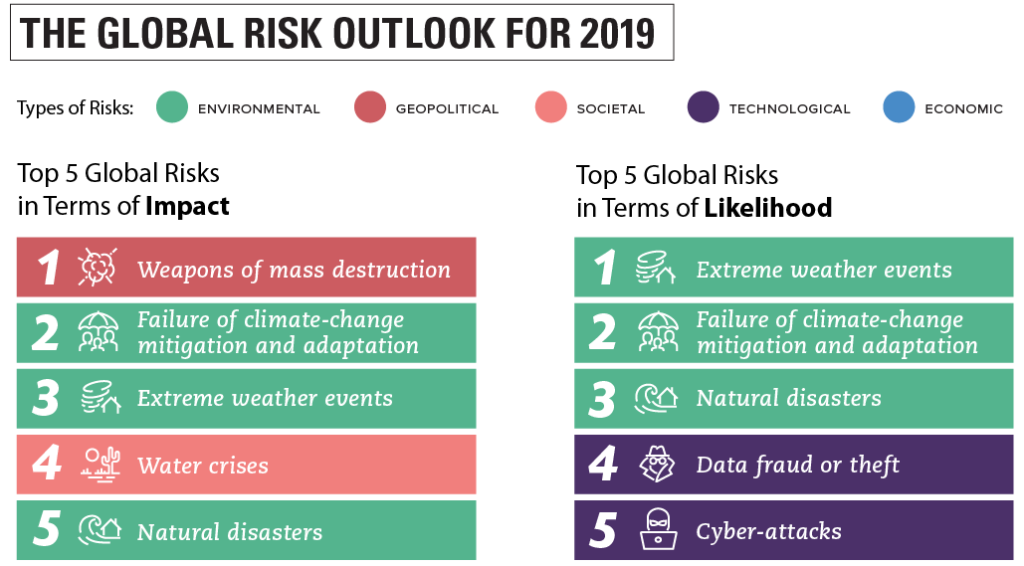
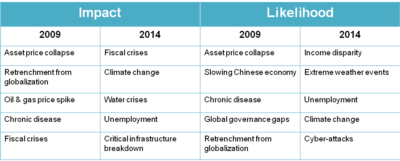 It is also interesting to look at the detailed 10 year table in the report to see how the risk perceptions have changed over the last decade.
It is also interesting to look at the detailed 10 year table in the report to see how the risk perceptions have changed over the last decade.



 The mining industry will see positive impacts from digitalization. Unfortunately more reliance on technology also brings with it significant risks. These risks are related to cyber security.
The mining industry will see positive impacts from digitalization. Unfortunately more reliance on technology also brings with it significant risks. These risks are related to cyber security. As your mining company continues to move into the digital world, you must ask:
As your mining company continues to move into the digital world, you must ask: The bottom line is that there is no stopping the digitalization of the mining industry. It is here whether anybody likes it or not. At the same time, there is likely no stopping the growth of cyber crime.
The bottom line is that there is no stopping the digitalization of the mining industry. It is here whether anybody likes it or not. At the same time, there is likely no stopping the growth of cyber crime.
 Mining companies are always on the hunt for new projects to grow their cashflows. They would all like to find the “perfect” project; one with ideal conditions and great attributes.
Mining companies are always on the hunt for new projects to grow their cashflows. They would all like to find the “perfect” project; one with ideal conditions and great attributes.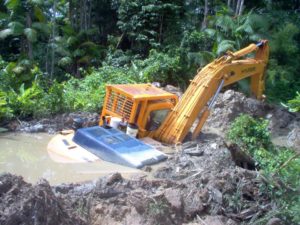 Now take an honest look at some recent (or past) projects that you have been involved with. How many of the perfect attributes listed above would be represented? It would be surprising to see them all checked off. Unfortunately that means certain flaws (risks) must be accepted when developing a project.
Now take an honest look at some recent (or past) projects that you have been involved with. How many of the perfect attributes listed above would be represented? It would be surprising to see them all checked off. Unfortunately that means certain flaws (risks) must be accepted when developing a project. The bottom line is that management understandably have a difficult task in making go/no-go decisions. Financial institutions have similar dilemmas when deciding on whether or not to finance a project.
The bottom line is that management understandably have a difficult task in making go/no-go decisions. Financial institutions have similar dilemmas when deciding on whether or not to finance a project.
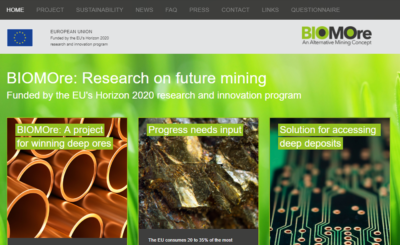
 The study concluded that accessing potential deposits at depths of around 1000 m is economically feasible only if curved wells are used. The most relevant operational parameters are sufficient permeability in the ore zone and an adequate contact surface between the ore and leaching solution. The depth of the deposit is indirectly relevant, but more importantly the well installation cost per volume of deposit is critical. Hence curved wells are optimal.
The study concluded that accessing potential deposits at depths of around 1000 m is economically feasible only if curved wells are used. The most relevant operational parameters are sufficient permeability in the ore zone and an adequate contact surface between the ore and leaching solution. The depth of the deposit is indirectly relevant, but more importantly the well installation cost per volume of deposit is critical. Hence curved wells are optimal. I am also curious about the ability to finance such projects, given the caution associated with any novel technology. Many financiers prefer projects that rely on proven and conventional operating methods.
I am also curious about the ability to finance such projects, given the caution associated with any novel technology. Many financiers prefer projects that rely on proven and conventional operating methods.
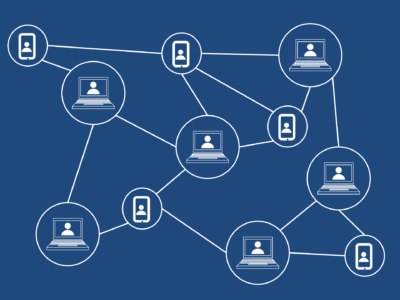 With regards to blockchain, it seems to me the main benefits are being related to supply chains, whether for purchasing or selling activities. Some of the examples given are that one can verify where the cobalt in your phone was mined or where your engagement diamond is from. Oddly though, I don’t recall ever wanting to know where the metal in my phone is from.
With regards to blockchain, it seems to me the main benefits are being related to supply chains, whether for purchasing or selling activities. Some of the examples given are that one can verify where the cobalt in your phone was mined or where your engagement diamond is from. Oddly though, I don’t recall ever wanting to know where the metal in my phone is from. We have seen in manufacturing that robotics will eliminate repetitive type jobs. Will robotic process automation (rPA) be able to do the same by completing repetitive tasks for us?
We have seen in manufacturing that robotics will eliminate repetitive type jobs. Will robotic process automation (rPA) be able to do the same by completing repetitive tasks for us? Collecting hoards of data from a site wide sensor network creates a dilemma in what to do with all the data collected. Smart cities are running into this issue. Who can sort through the data, decide what is important and what is noise, then summarize the data and report on it in real time? A human cannot deal with the amount of data being collected in such networks.
Collecting hoards of data from a site wide sensor network creates a dilemma in what to do with all the data collected. Smart cities are running into this issue. Who can sort through the data, decide what is important and what is noise, then summarize the data and report on it in real time? A human cannot deal with the amount of data being collected in such networks. Regarding the two technologies discussed in this blog, I personally feel robotic process automation will have far greater impact on mining industry future and its profitability.
Regarding the two technologies discussed in this blog, I personally feel robotic process automation will have far greater impact on mining industry future and its profitability.
 At a booth at the 2019 PDAC I had a chance to speak with a publicly traded company called
At a booth at the 2019 PDAC I had a chance to speak with a publicly traded company called  The algorithm then examines the cell data to teach itself which attributes correlate to known mineralization and which attributes correlate with barren areas. It essentially determines a geological “signature” for each mineralization type. There could be millions of data points and combinations of attributes. Correlation patterns may be invisible to the naked eye, but not to the computer algorithm.
The algorithm then examines the cell data to teach itself which attributes correlate to known mineralization and which attributes correlate with barren areas. It essentially determines a geological “signature” for each mineralization type. There could be millions of data points and combinations of attributes. Correlation patterns may be invisible to the naked eye, but not to the computer algorithm. I was told that many in the geological community tend to discount the AI approach. Either they don’t think it will work or they are fearing for their jobs. Personally I don’t understand these fears nor can I really see how geologists can ever be eliminated. Someone still has to collect and prepare the data as well as ultimately make the final decision on the proposed targets. I don’t see the downside in using AI as another tool in the geologist’s toolbox.
I was told that many in the geological community tend to discount the AI approach. Either they don’t think it will work or they are fearing for their jobs. Personally I don’t understand these fears nor can I really see how geologists can ever be eliminated. Someone still has to collect and prepare the data as well as ultimately make the final decision on the proposed targets. I don’t see the downside in using AI as another tool in the geologist’s toolbox.
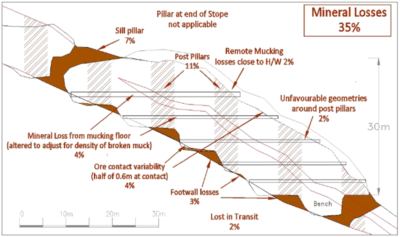 I am not going into detail on Paul’s paper, however some of my key takeaways are as follows. Download the paper to read the rationale behind these ideas.
I am not going into detail on Paul’s paper, however some of my key takeaways are as follows. Download the paper to read the rationale behind these ideas. The bottom line is that not everyone will necessarily agree with all the conclusions of Paul’s paper on underground dilution. However it does raise many issues for technical consideration on your project.
The bottom line is that not everyone will necessarily agree with all the conclusions of Paul’s paper on underground dilution. However it does raise many issues for technical consideration on your project.